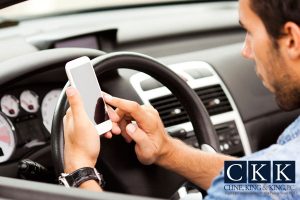 Distracted driving due to technology is a real threat. As drivers we recognize the hazards yet we continue to ignore what we know.
Distracted driving due to technology is a real threat. As drivers we recognize the hazards yet we continue to ignore what we know.
This is distracted driving by the numbers:
- 3,000 people die each year as a result of distractive technology.
- 2 in 3 drivers reported talking on their cell phone while driving in the past month.
- 1 in 3 (31.5 percent) drivers admit to typing or sending a text message or email while driving.
- 2 in 5 (42.3 percent) drivers report reading a text message or email while driving.
- People are more accepting of hands-free cell phone use than hand-held (63.1 percent vs. 30.8 percent).
- Research indicates drivers using handheld and hands-free phones only see about 50 percent of all the information in their driving environment.
- Less than half (42.4 percent) of drivers support an outright ban on using any type of cell phone (including hands-free) while driving.
- 58 percent of drivers believe it is acceptable to use cellphones while driving
- 60 percent of college students admit they maybe addicted to their cellphones.
The numbers clearly show distractive technology is a hazard. As drivers we know it but we don’t change our behavior. Why? As human beings we are so closely connected to cellphones that it becomes very difficult, if not impossible, not to “sneak a peek” at while driving. That is why distractions from technology while driving a vehicle must be achieved through design. It is possible. The following are some interesting ideas for consideration:
In 2005, Patent Application US 2005/0119002 A1 discussed a system for controlling wireless communication from a moving vehicle. The patent claimed an innovation regarding a system for preventing mobile phone conversations in vehicles traveling above a pre-defined speed without cutting off communication. The patent addresses previous art recognizing patent applications from the year 2001. In 2007, the above patent application was granted, US Patent No. 7,187, 953 B2.
In 2012, US Patent No. 8,131,205 B2 (filed April 30, 2009) discussed a mobile phone detection and interruption system method for vehicles. The patent discussed a system capable of being mounted in a vehicle and blocking communications between a mobile phone and cellular network responsive to the velocity of the vehicle and/or detection of a mobile phone communication in the vehicle.
In 2013, US Patent No. 8,384,555 B2 (filed January 11, 2010) discussed method and system for automated detection of mobile phone usage. In the patent, it discusses previous art related to the system.
In 2012, an article in a technical journal discussed a system to detect and block only driver’s usage of cellphone signals, but allowing passengers in a vehicle to continue to use their cellphones. The system involved a noninvasive, small size, mobile detection system with a jammer to detect the driver’s use of mobile phone and not the phone used by fellow passengers. The blocking of the mobile communication only occurred in the driver seating area.
The above systems do not rely upon our decisions as drives on whether or not to use a cellphone app to block a signal while driving. The design eliminates the hazard without our behavior becoming a factor. These designs are one piece of the puzzle in achieving Vision Zero.
Sources:
www.distraction.gov
www.nsc.org/learn/NSC-Initiatives/Pages/Technology-Reduces-Cell-Phone-Distracted-Driving.aspx
www.aaafoundation.org/sites/default/files/2015_TSCI.pdf
James A. Roberts, Luc Honore Petnji Yaya and Chris Manolis, (2104). The Invisible Addiction: Cell-Phone Activities and Addiction Among Male and Female College Students. Journal of Behavioral Addictions, 3(4), p. 254-265.
For further in-depth reading on the complexities required for everyday driving, see John Groeger, 2000, Understanding Driving, Applying Cognitive Psychology to a Complex Everyday Task. Psychology Press.
H. Abdul Shabeer, R.S.D. Wahida Banu, H. Abdul Zubar, (2012). Technology to prevent mobile phone accidents. Int. J. Enterprise Network Management, Vol. 5, No. 23, 2012.

 Quick, where is your cell phone? A pretty accurate guess for most readers is your cell phone is within arm’s reach, if not in your pocket or your hands. It probably has at least some portion of your attention right now, even as you’re reading this.
Quick, where is your cell phone? A pretty accurate guess for most readers is your cell phone is within arm’s reach, if not in your pocket or your hands. It probably has at least some portion of your attention right now, even as you’re reading this.